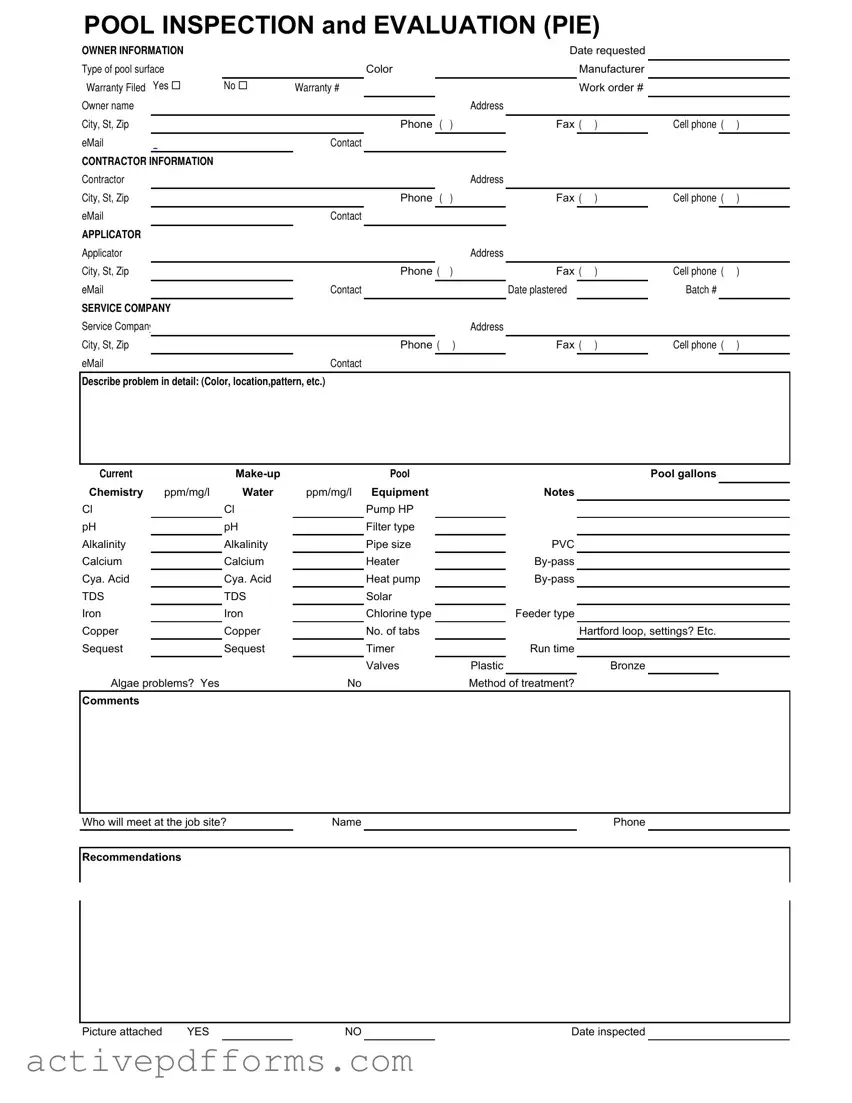What information is required from the pool owner in the Swimming Pool Inspection and Evaluation (PIE) form?
The PIE form requires comprehensive details from the pool owner, including the date the inspection was requested, the type of pool surface, its color, manufacturer, and warranty status (including the warranty number if applicable). It also necessitates the filing of a work order number, owner’s contact information (name, address, phone, fax, cell phone, and email), and a detailed description of the problem with the pool, focusing on aspects such as color, location, and pattern.
What contractor information must be provided in the PIE form?
The form requests detailed contractor information, including the contractor's name, address, and contact info (phone, fax, cell phone, and email). This section ensures that the contractor responsible for any pool repairs or inspections can be easily contacted and identified.
Who is the applicator, and what information is needed from them?
An applicator refers to the individual or entity directly involved in applying or installing the pool surface. Their name, address, contact details, and the date the pool was plastered, along with the batch number of the materials used, must be provided. This information is crucial for warranty and quality control purposes.
How should the service company information be filled out?
The form requires the name, address, and contact details of the service company managing the pool maintenance. Additionally, descriptions regarding the pool's current chemical makeup and any equipment notes are mandatory, aiding in a thorough evaluation of the pool’s condition.
Can you describe the type of pool problems that should be detailed in the form?
Pool problems needing detailed descriptions include, but are not limited to, issues with the color, pattern, and location of damages or anomalies found on the pool surface or within the pool’s operational systems. This detailed account helps in diagnosing the underlying issue more efficiently.
What pool chemical and equipment data is required?
The form demands specific readings of the pool’s chemical balance, such as chlorine levels, pH, alkalinity, calcium, and cyanuric acid levels, among others. Furthermore, it asks for details regarding the pool’s pump, filter type, pipe size, heater, and any other relevant equipment, ensuring a comprehensive understanding of the pool's operational status.
How is the inspection process documented in the form?
The inspection process is documented by detailing the problem, providing notes on the pool’s chemistry and equipment, and by attaching a picture, if applicable. The form also requires the name of the person who will meet at the job site for the inspection, along with their phone number, to ensure clear communication. The date the inspection was conducted is also noted for record-keeping.
Is there a section for recommendations after the inspection?
Yes, the form includes a section for recommendations, allowing inspectors or service technicians to suggest necessary repairs, adjustments, or improvements. This can include recommendations on chemical adjustments, equipment replacements, or physical repairs to the pool’s structure, offering a path toward resolving any identified issues.

